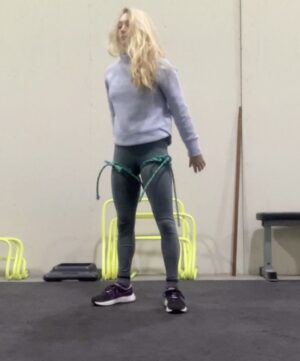
Blood Flow Restriction Training
In this article, we will discuss blood flow restriction training. We will discuss how to implement this type of training into your routine for maximum results.
What is Blood Flow Restriction Training?
Blood flow restriction (BFR) training is a type of training where you use tourniquets or bands wrapped tightly around the top of exercising limbs to reduce blood flow to your working limbs. For instance, you wrap your upper arms with tourniquets to cut off blood flow to your arms during biceps curls or triceps presses.
This type of training allows you to get a training response without using heavy loads. It works by increasing fatigue, metabolic stress, and increasing Type II fast twitch fiber contributions in the working limbs without the use of heavy or challenging loads.
So, instead of always having to train with heavy loads or close to failure, you can train with much lighter loads and still gain muscle, strength and power.
While BFR training may work well for a lot of people, it’s not for everyone. Some people with high blood pressure or other health problems might not be able to safely perform this type of training. Talk to your doctor before starting blood flow restriction training.
Blood Flow Restriction Protocols
Blood flow restriction training is often performed using a 30/15/15/15 protocol. With this protocol, you do 30 reps of an exercise with tourniquets wrapped around your upper arms or legs. Then, you rest 30 seconds, perform 15 reps, rest 30 seconds, perform 15 reps again, and rest 30 seconds, before a final 15 reps.
You could use this protocol with most exercises, but it works best with single joint exercises like bicep curls, leg extensions or leg curls.
You can also perform cardio with blood flow restriction tourniquets. Just walking for short periods with BFR tourniquets can help frail and elderly people prevent sarcopenia, gain muscle mass and promote bone growth.
Benefits
BFR training can help you gain muscle, strength, power. This type of training does not create as much muscle damage, soreness, or strain on joints or tendons as traditional resistance training protocols. Therefore, it can be a useful strategy to improve muscle and strength gains as part of a complete resistance training program.
Most people can perform one or two single joint exercises with a BFR protocol. However, BFR training should not replace all your traditional training. Traditional resistance training should still form the basis of your training.
Can You Use BFR Bands for Cardio?
You can actually use BFR bands for cardio. Place bands or tourniquets around your upper thighs while walking on a treadmill to increase the difficulty of your cardio workouts without increasing speed or incline. This type of cardio training increases cardiac demand without necessitating traditional high intensity work intervals.
Injury Rehab
BFR training can also help you exercise injured limbs without compromising recovery. Physical therapists sometimes prescribe BFR training to their patients. Blood flow restriction can help injured athletes rebuild strength, power and size without putting too much strain on a recovering body part.
If you currently have an injury but wish to perform blood flow restriction training, talk to a licensed physical therapist or sports medicine physician first.
How to Perform Blood Flow Restriction Training
To perform BFR training, you will need tourniquets, elastic bands, or any other bandage like material that you can wrap tightly around your limbs. Wrap your chosen bands or tourniquets around the top of your arms right underneath your shoulders, or at the top of your legs. You want to wrap the bands at a 7 out of 10 tightness. The bands should feel slightly uncomfortable, but not painful.
If performing resistance training, you can aim to perform the 30/15/15/15 protocol described earlier in this article. If performing cardio training, you can aim to walk for 5 to 15 minutes with bands or tourniquets wrapped firmly around your upper thighs.
What Exercises Can You Perform with Blood Flow Restriction Training
Technically, you can perform most arm or leg exercises with BFR training. For instance, you can perform bicep curls, triceps presses, squats, leg curls, or leg extensions. This type of exercise protocol can work with multi joint movements. However, blood flow resistance training is more practical with single joint movements that don’t require a high level of technical skill.
You can also use Blood flow restriction training while doing cardio training. Perform 5 to 15 minutes of walking, cycling or using an elliptical with bands or tourniquets around your upper thighs.
Final Thoughts
Blood flow restriction training can serve as a great addition for people who want to add more training volume without adding a lot of extra stress and strain to the body. This type of training can also work well for people with prior or current injuries.
What do you think? Do you use blood flow restriction training? Let me know in the comments below.